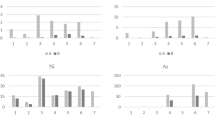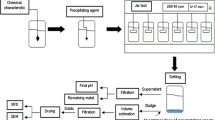Abstract
This article describes the characteristics of natural dusts, industrial dusts, and artificial dusts, such as mineral phases, chemical components, morphological observation and size. Quartz and calcite are the main phases of natural dusts and industrial dusts with high SiO2 and CaO and low K2O and Na2O in the chemical composition. The dissolution and electrochemical action of dusts in glutamic acid liquor at the simulated human body temperature (37 °C) in 32 h was investigated. The potential harm that the dust could lead to in body glutamic acid acidic environment, namely biological activity, is of great importance for revealing the human toxicological mechanism. The changes of pH values and electric conductivity of suspension of those dusts were similar, increased slowly in the first 8 h, and then the pH values increased rapidly. The total amount of dissolved ions of K, Ca, Na, and Mg was 35.4 to 429 mg/kg, particularly Ca was maximal of 20 to 334 mg/kg. The total amount of dissolved ions of Fe, Zn, Mn, Pb, and Ba was 0.18 to 5.59 mg/kg and in Al and Si was 3.0 to 21.7 mg/kg. The relative solubility order of dusts in glutamic acid is wollastonite > serpentine > sepiolite, the cement plant industrial dusts > natural dusts > power plant industrial dusts. The wollastonite and cement plant industrial dusts have the highest solubility, which also have high content of CaO; this shows that there are a poorer corrosion-resisting ability and lower bio-resistibility. Sepiolite and power plant industrial dusts have lowest solubility, which also have high content of SiO2; this shows that there are a higher corrosion-resisting ability and stronger bio-resistibility.














Similar content being viewed by others
References
Aiming L (2009) Research on the pollution property of atmospheric particulates in city region. Saf Environ Eng 16(6):15–19
Davidson CI, Phalen RF, Solomon PA (2005) Air borne particulate matter and human health: a review. Aerosol Sci Technol 39(8):737–749
Fangyin L, Feifei W, Mingyu D (2012) Cytotoxicity assessment of fine particles from coal combustion on EA.Hy926 vascular endothelial cells. China Environ Sci 32(1):156–161
Faqin D, Xiaochun H (2005) Superfine mineral dust and human health. Environ Health 393–395
Faqin D, Xiaochun H, Guowu L (2005) Study on the basic characteristics of several atmospheric dusts in the norther china. Mineral Petrol 25(3):114–117
Guowu L, Faqin D, Tongjiang P, Pu W (2000) Dissolubility and bio-resistibility of porous fibrous minerals in amino acid. Acta Petrol Mineral 19(3):220–225
Miriam JH, Thomas L (2007) Haze, clouds and limited sky visibility: polarotactic orientation of crickets under difficult stimulus conditions. J Exp Biol 210(18):3266–3276
Renjie C, Bingheng C, Haidong K (2010) A health-based economic assessment of particulate air pollution in 113 Chinese citles. China Environ Sci 30(3):410–415
Simkhovich BZ, Kleinman MT, Kloner RA (2008) Air pollution and cardiovascular injury: epidemiology, toxicology and mechanisms. J Am Coll Cardiol 52(9):719–726
Suwido HL, Hidenori T, Aswin DU et al (2007) Impacts of haze in 2002 on social activity and human health in Palangka Raya. Tropics 16(3):275–282
Funding
This study was supported by the Natural Science Fund (nos. 41130746 and40072020 ).
Author information
Authors and Affiliations
Corresponding author
Additional information
Editorial handling: D. Faqing
Rights and permissions
About this article
Cite this article
Ling, Z., Faqin, D. & Xiaochun, H. The dissolution of natural and artificial dusts in glutamic acid. Miner Petrol 109, 377–383 (2015). https://doi.org/10.1007/s00710-014-0345-3
Received:
Accepted:
Published:
Issue Date:
DOI: https://doi.org/10.1007/s00710-014-0345-3




